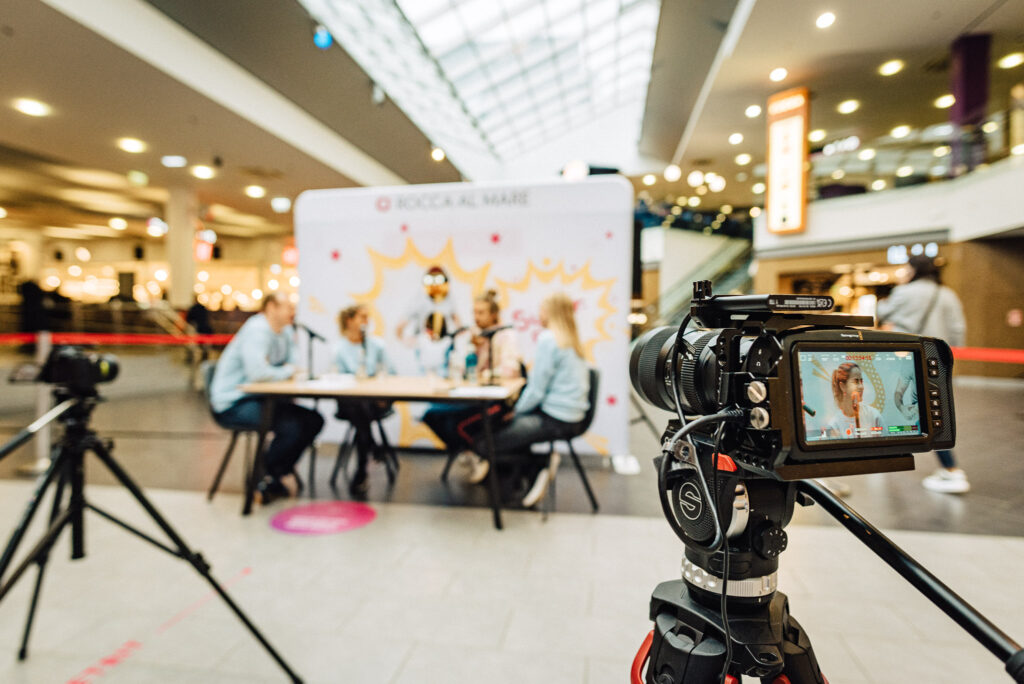The Rules of the Digital Age: Why a Smart Brand Can’t Afford Summer Silence
Year by year, there are fewer and fewer reasons to exclude summer from your communications plan. Digital media has changed the way people consume information to such an extent that staying silent in summer no longer signals a strategic pause, it means giving away visibility to a more active competitor.
Just five years ago, the common belief was: “Don’t try to push positive stories to the media in Summer; they’ll go unnoticed. People don’t consume media during summer.”
But the rise of digital media has shifted this. 91% of Estonians consume news on mobile devices. News reaches people everywhere: on the beach, in the forest, or on public transport. Summer no longer puts media consumption on pause. Only the way people consume information changes.
Today’s PR is about delivering the right content at the right time and place to the right audience. This no longer happens solely through a newspaper article or press release. The same story might reach someone through a social media platform, a community group or even an influencer. Summer is the best time to convey your brand’s message.
Be Where Your Client Is
As a communications agency, our first question to clients is: “What are your clients hiring you for?” That’s the core from which all meaningful action and visibility-building begins. People don’t choose brands because they’re loud, beautiful or active.
They “hire” brands to solve specific challenges in their life or work: to make decisions easier, provide confidence, bring clarity, spark ideas or improve their mood. If you know who your clients are, what you solve for them, and when they’re ready to listen, you won’t have “silent months” in your annual calendar. For many brands, summer can be one of the most effective periods to stand out: with less noise, more space, and a more receptive audience.
“Less noise, more space and a more receptive audience”
When You’re Present, You’re Remembered
When work pace slows and calendars open up, people start looking around. They reevaluate service providers, seek new solutions and shape new consumption habits. This is the moment when a brand can position itself meaningfully and calmly: without noise, but with purpose.
“A brand that understands its target audience also consumes content in summer, knows that vacation doesn’t mean needs disappear. It just means the environment is different. The same brand knows how to adapt its communication to this new environment.”
A Brand That Goes Silent in Summer Loses More Than Media Coverage
The best agencies build summer content packages, pitch season-appropriate stories to journalists, help leaders stay active on LinkedIn and involve influencers who convey the message naturally to consumers.
Marketing and executive leaders who understand that PR is not a seasonal campaign but a continuous trust-building effort use summer strategically. When most competitors go quiet, it’s easier to garner media attention: there’s more room for your message to be seen and a greater chance of being remembered.
Sponsorships in 2024: how to make them truly support business
The ongoing EOK (Estonian Olympic Committee) presidential elections seem to be once again centred around money — or rather, the lack thereof. However, if we look at larger sponsorship collaborations in sports, the picture seems different: Estonian companies have plenty of money. Unfortunately, while funds are allocated, collaboration opportunities are not maximised.
Imagine investing 15% of your marketing budget in a campaign but not measuring or adjusting the results along the way. It sounds unreasonable, right? Unfortunately, this is still quite common in sponsorship collaborations. The sad reality is that many are just “present.” The full potential of sponsorship is achieved when the brand not only displays its logo but engages the audience, creates value, and measures how the investment actually yields results.
The sad reality is that many are just “present.”
Collaboration with various events or individuals generally consists of three stages:
- Selection of collaboration projects and preliminary research.
- Development and implementation of a sponsorship activation strategy.
- Measuring effectiveness.
Who to collaborate with?
It is crucial to choose collaboration partners who share the company’s values and goals. Poor planning and expectation management often lead to unsuccessful collaborations. Here, the event or individual seeking sponsorship plays a significant role, as they must provide a clear value proposition and an overview of the target audience. Sometimes, even event organisers are unaware of their participants’ profiles and whom they are actually addressing.
Additionally, focus is essential. Just as we don’t trust influencers who collaborate with everyone, there’s little sympathy for companies that seem to support everything but offer nothing substantial. Focus is vital in sponsorships as well.
Just as we don’t trust influencers who collaborate with everyone, there’s little sympathy for companies that seem to support everything but offer nothing substantial.
The initiative must come from both sides
I have long been responsible for marketing various sporting events and communities (e.g., IRONMAN Tallinn and the Biathlon World Cup in Otepää), including managing sponsorship collaborations. Often, I found myself wanting to work with companies that might even give less money but were passionate about the cause. Unfortunately, 70% of the collaborations were more in the format of “you get cucumbers, I get money.” The primary output was limited to a few banners, logos in the competition guide, and a promotional video on social media.
The proposed list often had more topics, but unfortunately, these opportunities were frequently left untapped. This was because the company would have had to put in additional effort. The reasons varied but mainly revolved around a lack of commitment or time. It could also happen that the decision to support came from higher up, leaving the marketing manager to simply accept that their company was now a sponsor of a particular event or individual.
What value can sponsorship collaboration bring?
The brand collaboration aimed at customers:
- increasing brand awareness;
- positioning the brand among competitors and maintaining the brand image;
- developing the brand’s community;
- increase purchase intent and directly advertise products/services to the target audience.
A good example is the collaboration with Farmi during the Biathlon World Cup, where they aimed to reach a younger target group. They supported the construction of children’s tent at the supporter area, had different activities and provided it with all their new products therefore reaching to their needed audience.
Employer branding and internal communication:
- showing employees that the company values an active lifestyle;
- building the company’s image in the job market;
- involving employees in sponsorship collaborations;
- offering added value to both existing and potential employees.
Swedbank has shown significant benefits in sports projects, elevating its image as an attractive employer through its collaboration with the Tallinn Marathon, both internally and externally.
Developing partnerships:
- demonstrating commitment and enhancing the image among partners;
- different events’ VIP areas are excellent opportunities to host partner and client events.
It is proven that sponsors who invest in effective activation strategies for their sponsorships can achieve greater visibility, thereby increasing awareness of their sponsorships (Quester & Thompson 2001; Wakefield et al. 2007).
Community and dedicated fans
Fans care about brands that are deeply connected to local communities, not just during major moments. There is enormous potential at the local level that is currently untapped. For example, sports events often offer the opportunity to create branded emotional points through sponsorship. It’s as simple as setting up a few flags or banners, playing music, and gathering a crowd — no more is needed. The emotions participants get are invaluable. That feeling that someone is cheering them on and supporting them during the toughest moments of a marathon stays with them. If this is tied to a brand, there is a tendency to choose that brand’s products or services in the future.
At the IRONMAN event, these places were even offered for free because the organisers also wanted many people along the course and for participants to have valuable experiences. The company, in turn, can nicely display its brand.
In other words, sponsors need to make an effort to increase their visibility and make an impact. Just a banner is no longer enough; the company must genuinely show interest.
Sponsorship collaborations can be measured, too
Although very few do this. A survey by the market research agency MKTG revealed that just under 20% of surveyed companies’ sponsorship managers had developed a method to measure the return on investment (ROI) of their sponsorships. 73% of them stated that the main goal is “brand awareness,” and ROI was not the main focus of sponsorship. This trend indicates that while investments are increasing, many companies may not fully utilise their sponsorship opportunities.
Once again, collaboration with the event organiser is crucial for measuring effectiveness. Often, proactive communication with the organiser opens up various ways to further measure effectiveness. Naturally, it is impossible to quantify the entire collaboration, but saying it’s all just for brand spreading is simply lazy. Collaboration no longer involves placing logos on banners. As mentioned in the article, there are many ways to maximize collaboration. Even for direct advertising, solutions exist, starting with newsletters, which are among the most widely read emails (about 80-85% of participants usually read the content).In Estonia, sponsorship relationships are still in their infancy, whether it’s about supporting various events or athletes. They often depend on whether the marketing manager is passionate about leading projects. Good collaborations come from mutual initiative. Sponsorship is not charity but a bilateral strategic partnership!
Where to start with a communication strategy?
Developing a communication strategy is critical for any organisation that wants to communicate its messages and achieve its communication objectives effectively. While there is often pressure to include all the different aspects of what the organisation is doing, it is essential to focus on the opposite – keeping the strategy as clear and specific as possible. This is the only way to ensure a communication strategy is functional and practical across the organisation.
In general, the purpose of a communication strategy is to define the change that communication needs to drive in an organisation. Formulating a strategy directs all communication activities, thereby helping to avoid wasting resources on irrelevant issues and focus on genuinely practical steps to achieve the organisation’s objectives.
Here are five short suggestions on how to start creating a communication strategy:
1. Clearly define the purpose of the strategy.
Before writing a strategy, it is important to think about what the primary purpose should be. This means understanding what changes the communication needs to bring about in the organisation, whether it is raising awareness, changing attitudes or galvanising action. Having a clear purpose helps to keep the whole process of creating a strategy focused, and the resulting strategy can be used to inform action across the organisation.
2. Analyse the current situation and the change needed.
Conduct a thorough analysis of your organisation’s current communication situation and identify the areas that need to change or improve as a priority. This includes internal and external communications, the effectiveness of existing messages and understanding of target audiences.
3. Map target groups and stakeholders.
Specify who your main target groups and stakeholders are that you want to reach with your communication strategy. Consider which groups are most important to achieve the strategy’s objectives and how to tailor your communication to their needs.
4. Articulate the key messages and tailor them to the needs of target audiences and stakeholders.
Once you have mapped your target and stakeholder groups, clearly articulate the key messages that reflect the objectives of your strategy. Then, tailor these messages to the specific characteristics and preferences of each target group and stakeholder. This will ensure that your messages resonate effectively with different groups, increasing the impact of your communication.
5. Choose the most appropriate channels and methods.
Choose the most effective channels and methods to disseminate your messages based on your objectives and an analysis of your target audience. This could mean using traditional media channels, developing a social media strategy or even direct marketing, depending on what works best for your target audiences.
The worst strategies are the ones that people spend a lot of time and resources on but will never be used. Therefore, avoid being vague and piling up unnecessary policies you don’t have the resources to implement. In the communication strategy, focus only on what is essential for achieving the organisation’s objectives for the next period or where communication plays a key role.
Andreas Kaju: Open Tap Policies Have Rarely Brought Long-Term Success

This article first appeared in Äripäev on 15 May 2021.
I am concerned about the sloganeering of the debate on the state budget and the national debt. It can give the impression to a citizen who is informed only through the press that on one side of the debate there are fiscal conservatives defending the principle of a balance between expenditure and revenue, and on the other side there are ideologues with good ideas and a desire to find the money to bring them to life.
The real starting point is this. Estonia’s debt level has already risen threefold in the last two years, from 8.4% of GDP to 23.6% of GDP, and the structural fiscal position of the general government has increased by the same magnitude, from 2.7% to -6.6%. Every second, Estonia borrows to finance its existing legal obligations, without a blink. And the artificial recession caused by pandemic restrictions (which are holding back supply; there is plenty of demand) is not yet over. Maybe we will live like this for years to come, where we will have to subsidise the recovery of whole sectors of the economy with wage subsidies and so on. All of this is obviously necessary, because society will bear the excess costs in solidarity to protect the most vulnerable.
In other words: In Estonia, the budget deficit is growing even before any debate, and it has been so for several years before the crisis, when, despite economic growth, it managed to spend more than it raised.
Concrete-constrained fantasy
The ‘open taps policy’ of which Finance Minister and Prime Minister Otto Strandman accused Konstantin Päts, and which led to his dismissal as head of state back in 1924, has very rarely been a long-term success. In the short term, of course, it is inevitable in pandemic circumstances – the euro area’s public debt has also crossed the 100% of GDP threshold and avoiding social collapse is the government’s first task. The problem is, above all, that Estonia has not yet had a government that has been able to open the taps and make long-term investments, in addition to covering current expenditure, without visible results before the next elections.
The ‘open taps policy’ of which Finance Minister and Prime Minister Otto Strandman accused Konstantin Päts, and which led to his dismissal as head of state back in 1924, has very rarely been a long-term success.
This is why the so-called investment money is always poured into concrete and asphalt. For example, in the health sector in Estonia, almost the entire period of EU membership, structural funds and co-financing for investments have been used for concrete investments.
Even today, fantasy is limited to concrete. A major project for the new Tallinn hospital may be justified to consolidate the existing city hospitals operating in old buildings, but in the circumstances where we have regional hospitals PERH and TÜK and already today one does not have enough residents and the other does not have enough patients, our real estate-oriented investment philosophy is simply strange.
In education, too, investment has always been only in building houses. In a country of faith in education, the popularity of the teaching profession is still among the lowest in the OECD countries, because children leaving school see how difficult it is for a teacher to be alone in the classroom and how little real support he or she has.
The reason for investing in building is that the process is simple, the result tangible. We order the houses, the bank knows how to price, the builder builds, the owner depreciates, and for a while everyone is happy, the economy grows.
The state is a poor investor not only because these investments are not managed as they should be, but also because it does not know how to invest. With a low appetite for risk (historically, KredEx’s business support measures have been so conservative that demand for them has sometimes been poor, although the situation has improved in recent months) and a time horizon that is always close at hand, the state does not invest in companies at the crossroads of science and modern manufacturing in Estonia, or in education and science, but primarily in construction.
Take a look at Finland or Germany – what is the level of investment there by the public sector, central government or counties and cities? There is competition for production and technology transfer opportunities for companies, and centres of excellence are set up with innovative R&D-intensive companies. In the health sector, interesting new interventions and prevention policies are being funded to help extend healthy life years.
I am not going to talk about 6G, artificial intelligence, the energy revolution or the impossibility of developing any industry at all outside Ida-Virumaa region in Estonia.
Our great development obstacle
If the government wants to invest, it should do so where private sector investment and the expected impact would otherwise not reach. In today’s macro-environment, any marketable business idea can get money, it doesn’t necessarily need the state. Yes, Estonia’s capital market is still fragile, but the rapid development of recent years has included the growth of local investment firms and hedge funds. In Estonia, it is easy to start a new business, raise money, develop it, sell it and start again.
In today’s macro-environment, any marketable business idea can get money, it doesn’t necessarily need the state.
Where there is not enough private capital in Estonia: fundamental and applied science, universal education, giving all children a level playing field, but also political competition to attract or retain large investments.
The Estonian economy is actually doing well at the moment, even if it is hard to believe in the middle of a pandemic. It does not need concrete money. Estonia, like many other countries, has one major brake on development – a chronic shortage of people with different skills. This is true in the fastest growing and highest value-added technology industries but also in agriculture and food production, health care and the service sector. Everywhere. No people, no skills. If we can create a greater concentration of people and skills, there will be growth, innovation (which unambiguously depends on the concentration of talent and interactions between them) and culture.
Finally, a reminder for our fellow entrepreneurs. As soon as the new government’s tax peace is over, the debate will begin on how to plug the annual deficit with rising budget revenues in addition to borrowing. Money can be taken from where it is earned. In Estonia, the Reform Party has always loved to tax consumption, while the other major parties have never had any serious ideas to put on the table (to Jüri Ratas’ credit: he did try to start a tax debate, but the pandemic and real life ruined it). Unless people’s grocery list or homes are not to be taxed further, the money will have to come from where it is. You know.
A new trend – the role of communication manager is fully entrusted to an agency

More and more international and Estonian companies are moving in a direction where the entire work of a communication department is outsourced to an agency. Is this decision justified, and in that case, what is the key to smooth cooperation?
Although, at the beginning of the COVID-19 crisis, it was thought that many companies would manage communication with the help of in-house staff, the reality has turned out the opposite. Even before the crisis, the trend of outsourcing the entire communication management service had begun to grow. In particular, from an agency that provides a full service – strategic communication, daily media communication, and social media as well as internal communication.
In order to make such a cooperation smooth, one person should still be responsible for marketing and communication in-house. Whether it is a marketing or communication manager, the two areas are so intertwined and should, ideally, support each other, it doesn’t matter how the responsible person is titled. However, it is common that the person responsible for communication in the company is the marketing or brand manager.
Agency vs communication or marketing manager
Outsourcing the entire communication service is especially common in international companies, which very often connect the Estonian, Latvian and Lithuanian markets and outsource all project management and daily communication from one agency.
For years, Coca-Cola and McDonalds, for example, have been doing the same, outsourcing all communication management. According to Nele Normak, Coca-Cola’s Head of Public Relations in the Baltics, this is both cost-effective and significantly more convenient for the person in charge. “A few years ago we made the strategic decision to consolidate marketing, PR, and government communication under one single agency.
Different brands need a diverse range of communication to reach their target groups and get the best results. The use of an agency adds freshness, and offers innovative approaches and diverse perspectives,” explained Normak.
A similar example is Citycon, where the marketing team consists of marketing and communication manager Helina Leif, and the coordinator of the shopping centers. The latter mainly dealing with internal communication. Their communication service is outsourced entirely to META Advisory.
“Other Nordic countries with a number of Citycon shopping centers have their own communication managers. Similarly to Denmark, Citycon has only two centers in Estonia (very few compared to Norway, where there are 24 centers – H.L.), whose communication needs and volumes do not require the hiring of a separate specialist. However, I feel that since, in Estonia, my area of responsibility is both marketing and communication, the use of a PR agency is absolutely essential during the high season. Firstly, it is cost-effective; and secondly, I appreciate the agency’s support, particularly in crisis communication issues and media relations. When publishing data or news, it is often good to have an impartial partner who has no connection to Citycon. That helps to see the bigger picture and to provide better comments, which also have a greater impact on the customer, who does not know the background of the center’s decisions,” Leif explained.
Which is more cost-efficient?
Many are afraid to hire an agency fearing it would be very expensive. In practice, however, hiring an agency is sometimes more cost-efficient than hiring one high-level communication professional. Especially because obtaining services from the agency provides access to specialists of several different areas, who will help to grow both the company’s reputation and the sale of your product or service. Today, a modern communication agency offers services to help build product and service brands, to plan marketing based on customer segments, and to build a company’s reputation and develop it from month to month, as well as managing the company’s relationship with the public, media and local community.
Especially in times of crisis the agency can be of great help, as there are experts who have managed the crisis communication of several companies and gained valuable experience. Thanks to this, it is possible for a company to feel more secure every day.
The 2020 labor market survey done by CVKeskus.ee, the largest employment portal in Estonia, and the Salary Information Agency, revealed that the median gross salary in Estonia for a marketing and communication specialist is 1,400 euros and 1,850 euros for a top specialist. At the same time, it is true that an experienced communication manager is no longer attracted to such a fee. However, it is possible to get a monthly contract from the agency for the same amount of money, which can cover the basic needs of a smaller company.
Ask META for an offer today and write to ann.hiiemaa@metaadvisory.ee
The Green Turn finally reaches everyone

Climate change, plastic pollution, and biodiversity loss – these problems are all increasingly at the heart of the populations of advanced societies, affecting consumption decisions and governments around the world.
The Green Turn is no longer just an intellectual topic of discussion at the dinner table for well-off citizens in hipster districts. It is a reality and directly affects each of us, touching virtually every business sector and continent, from the EU Green Deal to Joe Biden’s ambitious climate plan, as well as Japan’s and China’s increasing efforts in implementing the Green Turn.
Although the climate debate often gives the impression that the energy sector plays a key role in reducing emissions, i.e. stopping the burning of fossil fuels, this is only half the truth – if at all. Everyone must contribute to a climate-neutral society: the individual in their daily life and in their consumption decisions; the entrepreneur by innovating their services or products; and society as a whole by creating and framing policies through the democratic process.
Over the years I have advised companies operating in a wide variety of business areas. Today, there is no one in my portfolio for whom sustainability or green thinking is not an important issue. And not only in terms of communication, but fundamentally – on a strategic level. However, it seems to me, a great many companies have not yet taken steps in this direction. I do not know whether it is a lack of knowledge or indifference, but I am sure of one thing – sooner or later everyone will have to face the changes that are driving the green revolution. And it is better to deal with them sooner rather than later.
The Green Turn can be perceived differently. On the one hand, there are restrictions on the freedom of enterprise, along with additional obligations and limitations. On the other hand, it contributes to a better living environment and creates new opportunities for many companies and economies, to become more prosperous.
Both attitudes are also transferred to corporate communication. It is quite easy to see who is doing climate or sustainability communication simply because others are doing it, and therefore believe they should also do something. But other companies have content and communication going hand in hand, each supporting the other.
In general, my advice is the following: if you do nothing, then better not to talk, but if you want to talk, then start doing.
Green aspirations must not exist in communication alone. There must be deeds behind the words. Believe me, the green literacy of journalists and consumers has greatly improved and there is no point in attempting to pull the wool over their eyes. It is so transparent. The stupidest thing is to get caught up in greenwashing. There are companies, both here and in the rest of the world, who have stepped in shit with both feet already. Terms such as environmentally friendly, carbon neutral, natural, ethical or sustainable should only be used if they are based on real action. Words alone no longer work; the conscious consumer is aware of the finest nuances of greenwashing.
If the foundation is laid properly, strong walls and a roof can be built on it. The value of modern communication should be to generate business benefits for a company, not just to capture attention. The core strength of a communications consultant lies in how to convert sustainability communication into success in key business areas.
What does this mean? Various studies have shown that sustainable companies are becoming more and more attractive for both investors and cooperation partners, and strategic communication plays a very important role in highlighting these values. It is necessary to explain, to the target groups important for the company, what they gain from the company’s use of environmentally friendly technologies, and what green thinking and innovation brings to them, as well to other customers, partners, and existing or future employees. It is necessary to explain to each target group, how the company’s green aspirations affect them and make their life better.
I have noticed that many companies are afraid to set ambitious goals, because they are afraid that they may not meet them. This should not be an obstacle. Even if the targets are not met in one year, it should be publicly acknowledged and pronounced, clearly, what will be done to succeed next time. Clear and measurable goals and the efficient communication of them is always a good way to announce your green aspirations.
It is obvious that by hiding their heads in the sand, all companies face a situation, sooner or later, where they have to adapt to new realities or lose out by becoming the losers of a changing world.
Let’s follow the example of organizations that are taking both big and small steps towards a better future, and welcome the change with gratitude. After all, this is actually being done for the benefit of all of us and our future generations. Let’s stop living at the expense of the environment and start cooperating with nature. As we introduce new practices, we actually quickly realize how natural and logical this is for all of us. It is not worth seeing the Green Turn as coercion. This is an opportunity. Both in terms of commerce and communication.

NB! Microsoft on loobunud Internet Exploreri arendamisest ning sellele uuenduste tegemisest ja ei soovita antud internetibrauserit turvanõrkuste tõttu kasutada. Internet Explorer ei toeta enam uusi võrgustandardeid ning antud veebilahendus ei tööta siinses brauseris korrektselt.
Palun lae alla mõni moodne veebilehitseja:
The website uses cookies. Cookies are required for your convenience and web statistics. By continuing to use the website, you agree to the terms of the privacy of cookies! You can see the terms of the privacy policy in here.






